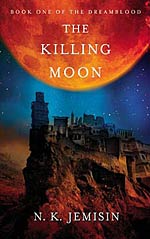
![]() bazhsw
bazhsw
9/27/2013
![]()
The Killing Moon is set in the City State of Gujaareh. Priests of the dream goddess harvest the dreams of the sick and dying in turn sending the ill to eternal peace. The harvesters are known as Gatherer's and are unrelenting in their dedication to fulfilling their tithes. As well as Gathering from the old the Gatherer's also kill those judged corrupt by the state.
The novels focus is on Gatherer's Ehiru and Nijiri who have a mentor and apprentice relationship and the recipient of one of their tithes - the ambassador Sunaidi of the nearby state of Kisua.
Ehiru has to question everything he believes in when bodies start to turn up in Gujaareh and he temporarily suspends the killing of Sunaidi.
The novel is very loosely based on Egyptian mythology, which as other commentators have mentioned makes a nice change from fantasy novels rooted in mediaeval European mythology.
One thing I really liked about the novel was the world building. The city feels vibrant and real - the colours,sounds and smells of the city are evocative. Jemisin has a clearly defined culture, religion and mythology to Gujaareh which makes sense. The reader is drip fed this information throughout the novel which is good compared to other novels where you just get hit with info dumps of pages and pages of history and geography to set the world.
A key theme of the novel is that of love and I found the relationship between Ehiru and Nijiri to be exceptionally well written. I was genuinely touched by the relationship which was like father and son, apprentice and mentor, brothers and lovers all rolled into one. There is genuine love between the two but it's expression in each is different.
The novel is also one of political intrigue and nation states on the brink of war. This plot hook wasn't the most original. The mid part of the novel did seem to drag a little which detracted from my novel a little.
I probably will read the sequel in the future as the world building and characterisation are really good.